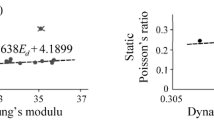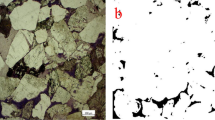Abstract
In the present approach, clast geometric parameters—particle size distribution (PSD), clast complexity \((D^{R})\), aspect ratio (AR), circularity (Circ), convexity (Conv) and clast orientation (Angle)—were examined in order to separate the diverse fault rock types (fault breccias, cataclasites and fault gouges), which typically own extremely different hydraulic and petrophysical properties. The available borecore samples were studied in a case of a thrust fault zone from the metamorphic basement of the Pannonian Basin, Hungary. Multivariate statistical methods were applied in order to find the geometric parameters that define the tectonites. The calculated discriminant functions emphasized the importance of the PSD, Angle, AR, and Circ parameters, in descending order. We defined proper combinations of geometric parameters which can clearly separate the fault rock groups, both pair-wise and jointly for the three groups. The discriminant functions also pointed out the relatively similar geometric features of fault breccias and cataclasites in contrast to the significantly different characteristics of fault gouges. The multidimensional scaling demonstrated a three-phase evolution of the analysed brittle tectonites, where the initial deformation is coupled with chaotic fabric giving a weakly disaggregated fault breccia texture. The transitional stage can be characterised by cataclastic flow, while in the most deformed fault gouge samples the strong fragmentation, clast-rounding and oriented texture dominate. These results possible provide constraints on the development and overall behaviour of the fault zone.










Similar content being viewed by others
References
Antonellini M, Aydin A (1995) Effect of faulting on fluid flow in porous sandstones: geometry and spatial distribution. Am Assoc Pet Geol Bull 79:642–671
Barnett W (2004) Subsidence breccias in kimberlite pipes—an application of fractal analysis. Lithos 76:299–316
Ben-Zion Y, Sammis CG (2003) Characterization of fault zones. Pure Appl Geophys 160:677–715
Bérubé D, Jébrak M (1999) High precision boundary fractal analysis for shape characterization. Comput Geosci 25:1059–1071
Biegel RL, Sammis CG, Dieterich JH (1989) The frictional properties of a simulated gouge having a fractal particle distribution. J Struct Geol 11:827–846
Billi A (2007) On the extent of size range and power law scaling for particles on natural carbonate fault cores. J Struct Geol 20:1512–1521
Billi A, Storti F (2004) Fractal distribution of particle size in carbonate rocks from the core of a regional strike-slip fault zone. Tectonophysics 384:115–128
Billi A, Salvini F, Storti F (2003) The damage zone-fault core transition in carbonate rocks: implication for fault growth, structure and permeability. J Struct Geol 25:1779–1794
Bistacchi A, Massironi M, Menegon L (2010) Three-dimensional characterization of a crustal-scale fault zone: the Pusteria and Sprechenstein fault system (Eastern Alps). J Struct Geol 32:2022–2041
Blenkinsop TG (1991) Cataclasis and processes of particle size reduction. Pure Appl Geophys 136:59–86
Brodie K, Fettes D, Harte B (2007) Structural terms including fault rock terms. In: Fettes D, Desmonds J (eds) Metamorphic rocks: a classification and glossary of terms. Cambride University Press, Cambride, pp 24–31
Caine JS, Evans JP, Forster CB (1996) Fault zone architecture and permeability structure. Geology 24:1025–1028
Cattell RB (1966) The scree test for the number of factors. Multivariate Behav Res 1:245–276
Chester FM, Friedman M, Logan JM (1985) Foliated cataclasites. Tectonophysics 111:139–146
Cladouhos TT (1999) Shape preferred orientations of survivor grains in fault gouge. J Struct Geol 21:419–436
Clark C, James P (2003) Hydrothermal brecciation due to fluid pressure fluctuations: examples from Olary Domain, South west Australia. Tectonophysics 366:187–206
Engelder JT (1974) Cataclasis and the generation of fault gouge. Geol Soc Am Bull 85:1515–1522
Evans JP, Forster CB, Goddard JV (1997) Permeability of fault-related rocks and implications for fault-zone hydraulic structure. J Struct Geol 19:1393–1404
Faulkner DR, Jackson CAL, Lunn RJ, Schlische RW, Shipton ZK, Wibberley CAJ, Withjack MO (2010) A review of recent developments concerning the structure, mechanics and fluid flow properties of fault zones. J Struct Geol 32:1557–1575
Fossen H, Schultz RA, Shipton ZK, Mair K (2007) Deformation bands in sandstone: a review. J Geol Soc 164:755–769
Hausegger S, Kurz W, Rabitsch R, Kiechl E, Brosh FJ (2010) Analysis of the internal structure of a carbonate damage zone: implications for the mechanisms of fault breccia formation and fluid flow. J Geol Soc 32:1349–1362
Hecht CA (2000) Appolonian packing and shape of grains improving geomechanical properties in engineering geology. Pure Appl Geophys 157:487–504
Heilbronner R, Keulen N (2006) Grain size an grain shape analysis of fault rocks. Tectonophysics 427:199–216
Hirono T, Sakaguchi M, Otsuki K, Sone H, Fujimoto K, Mishima T, Lin W, Tanikawa W, Tanimizu M, Soh W, Yeh E, Song S (2008) Characterization of slip zone associated with the 1999 Taiwan Chi-Chi earthquake: X-ray CT image analyses and microstructural observations of the Taiwan Chelungpu fault. Tectonophysics 449:63–84
Jébrak M (1997) Hydrothermal breccias in vein-type ore deposits: a review of mechanisms, morphology and size distribution. Ore Geol Rev 12:111–134
Jeppson TN, Bradbury KK, Evans JP (2010) Geophysical properties within the San Andreas Fault Zone at the San Andreas Fault Observatory at Depth and their relationships to rock properties and fault zone structure. J Geophys Res 115:B12423. doi:10.1029/2010JB007563
Kaye BH (1989) A random walk through fractal dimension. VCH Publishers, New York
Keulen N, Heilbronner R, Stünitz H, Boullier AM, Ito H (2007) Grain size distributions of fault rocks: a comparison between experimentally and naturally deformed granitoids. J Struct Geol 29:1282–1300
Lalonde M, Tremblay G, Jébrak M (2010) A Cellular Automata Breccia Simulator (CABS) and its application to rounding in hydrothermal breccias. Comput Geosci 36:827–838
Laznicka P (1988) Breccias and coarse fragmentites. Petrology, environments, associations, ores. Dev Econ Geol 25:842
Lee H, Kim H (2005) Comparison of structural features of the fault zone developed at different protoliths: crystalline rocks and mudrock. J Struct Geol 27:2099–2112
Lin A (1999) S-C cataclasite in granitic rock. Tectonophysics 304:257–273
Manzocchi T, Childs C, Walsh JJ (2010) Faults and fault properties in hydrocarbon flow models. Geofluids 10:94–113
Maros Gy, Pásztor Sz (2001) New and oriented core evaluation method: ImaGeo. Eur Geol 12:40–43
Mort K, Woodcock NH (2008) Quantifying fault breccia geometry: Dent Fault, NW England. Journal of Structural Geology 30:701–709
Nelson RA (2001) Geologic analysis of naturally fractured reservoirs, 2nd edn. Gulf Publishing Company Book Division, Houston
P’an CH (1982) Petroleum in basement rocks. Am Assoc Pet Geol Bull 66:1597–1643
Passchier CW, Trouw RAJ (2005) Microtectonics. Springer, New York
Petford N, McCaffrey KJW (2003) Hydrocarbons in crystalline rocks. Geol Soc Spec Publ 214:1–5
Posgay K, Bodoky T, Hegedűs E, Kovácsvölgyi S, Lenkey L, Szafián P, Takács E, Timár Z, Varga G (1995) Asthenospheric structure beneath a Neogene basin in southeast Hungary. In: Cloetingh S, D’Argenio B, Catalano R, Horváth F, Sassi W (eds) Interplay of extension and compression in basin formation. Tectonophysics, vol 252, pp 467–484
Sammis CG, Osborne RH, Anderson JL, Banerdt M, White P (1986) Self-similar cataclasis in the formation of fault gouge. Pure Appl Geophys 124:54–77
Sammis CG, King G, Biegel R (1987) The kinematics of gouge deformation. Pure Appl Geophys 125:777–812
Schubert F, Diamond LW, Tóth MT (2007) Fluid-inclusion evidence of petroleum migration through a buried metamorphic dome in the Pannonian Basin, Hungary. Chem Geol 244:357–381
Sibson RH (1977) Fault rocks and fault mechanisms. J Geol Soc 133:191–213
Sibson RH (1986) Brecciation processes in fault zones: inferences from earthquake rupturing. Pure Appl Geophys 124:159–174
Storti F, Balsamo F (2010) Impact of ephemeral cataclastic fabrics on laser diffraction particle size distribution analysis in loose carbonate fault breccia. J Struct Geol 32:507–522
Storti F, Billi A, Salvini F (2003) Particle size distributions in natural carbonate fault rocks: insights for non-self similar cataclasis. Earth Planet Sci Lett 206:173–186
Storti F, Balsamo F, Salvini F (2007) Particle shape evolution in natural carbonate granular wear material. Terra Nova 19:344–352
Stünitz H, Keulen N, Hirose T, Heilbronner R (2010) Grain size distribution and microstructures of experimentally sheared granitoid gouge at coseismic slip rates—crtieria to distinguish seismic and aseismic faults? J Struct Geol 32:59–69
Tanaka H (1992) Cataclastic lineations. J Struct Geol 14:1239–1252
Tari G, Dövényi P, Dunkl I, Horváth F, Lenkey L, Stefanescu M, Szafián P, Tóth T (1999) Lithospheric structure of the Pannonian basin derived from seismic, gravity and geothermal data. In: Durand B, Jolivet L, Horváth F, Séranne M (eds) The Mediterranean basins: tertiary extension within the Alpine orogen. Special Publications, vol 156. Geological Society, London, pp 215–250
Tóth MT (2008) Repedezett, metamorf fluidumtárolók az Alföld aljzatában. Academic Doctoral Thesis (in Hungarian)
Tóth MT, Redlerné TM, Kummer I (2009) Structural evolution of Szeghalom Dome on the basis of petrological and seismic data. Hung Geophys 29:143–151 (in Hungarian with English abstract)
Turcotte DL (1986) Fractals and fragmentation. J Geophys Res 91:1921–1926
Wibberley CAJ, Shimamoto T (2003) Internal structure and permeability of major strike-slip fault zones: the Median Tectonic Line in Mie Prefecture, Southwest Japan. J Struct Geol 25:59–78
Woodcock NH, Mort K (2008) Classification of fault breccias and related fault rocks. Geol Mag 145:435–440
Acknowledgments
We thank MOL Hungarian Oil and Gas Company for providing the samples and the financial support of this research. We are grateful to Gyula Maros (Hungarian Geological and Geophysical Institute) for his help in the use of ImaGeo corescanner. English was corrected by Proof-Reading-Service.com.
Author information
Authors and Affiliations
Corresponding author
Rights and permissions
About this article
Cite this article
Molnár, L., Tóth, T.M. & Schubert, F. Statistical characterization of brittle and semi-brittle fault rocks: a clast geometry approach. Acta Geod Geophys 49, 527–550 (2014). https://doi.org/10.1007/s40328-014-0067-3
Received:
Accepted:
Published:
Issue Date:
DOI: https://doi.org/10.1007/s40328-014-0067-3




